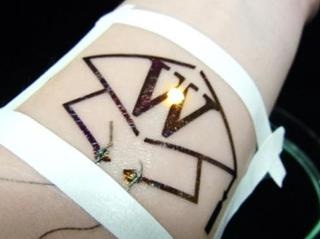Feb 23 2017
 This is a sandwich of printed circuits and SBS elastomer is just 750 nm thick, for extremely high flexibility and comfort. CREDIT: Waseda University
This is a sandwich of printed circuits and SBS elastomer is just 750 nm thick, for extremely high flexibility and comfort. CREDIT: Waseda University
A research team from Waseda University, Japan, has created innovative techniques as well as materials for producing ultrathin stick-on electronic devices by using elastomeric “nanosheet” film.
The outcomes of their research are effortless production with a preservation of flexibility and high elasticity, which is 50 times superior when compared to earlier reported polymer nanosheets.
The study has been published online in the 1 February issue of Journal of Materials Chemistry C.
There is a high demand for smart electronics and wearable devices in a range of applications, specifically considering their wearing comfort and ease of fabrication. The techniques and materials developed by the Waseda researchers denote on-par progress in both the criteria.
Inkjet printing of integrated circuits and their low-temperature fixing enable the fabrication of not only functional and durable electronic devices but also devices that are exceptionally thin and can be flexibly used as a skin-fitting and comfortable appliance.
Such devices also ensure protection of elastomeric films and easy handling features. The new film produced by the researchers is just 750 nm, and hence flexible and ultra-thin. The progress in this field can transform the properties of wearable electronics from articles such as wristwatches to objects much smaller than a band-aid.
The research team also formulated a technique for joining electronic components without the need for soldering, thus enabling thinner and much flexible elastomer films such as polystyrene-polybutadiene-polystyrene (SBS). The inkjet printing process can be used to create a conductive “wiring” by means of a household type printer without the requirement for clean room conditions.
Additionally, conductive elements and lines (e.g. LEDs and chips) are connected through adhesive sandwiching between two elastomeric nanosheets, without the need for providing chemical bonding by means of special conductive adhesives or soldering.
The uncomplicated and low-temperature techniques enable the produced ultrathin structures to attain better comfort in the case of skin-contact applications, higher elasticity, and greater adhesion, without the use of even adhesive materials such as glue or tape. The new material was found to be functional for many days when used on an artificial skin model.
The positive outcomes are the result of an alliance between three areas of specialization, which was possible due to cooperative streams at Waseda University: medical robotics and rehabilitation engineering; molecular assembly and biomaterials science; and micro-electromechanical systems.
The products are anticipated to be applied in the field of human-machine interfaces and sensors used for electronic tattoos, and as fundamentally enhanced implements used in healthcare, medicine, and sports training fields.
Additional analyses of these applications are ongoing in the Waseda University Institute of Advanced Active Aging Research.